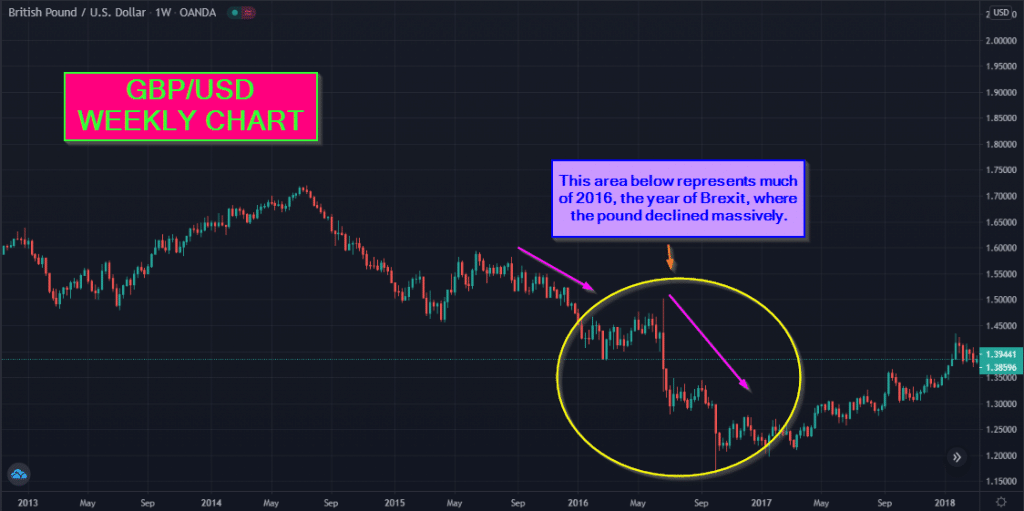Do you wish to be the ‘Warren Buffett’ of forex? You may want to consider position trading, which is a buy (or sell) and hold trading approach where orders are held anywhere for several months to years through mostly analyzing deep fundamentals.
What is position trading?

Position trading is an approach in forex seeking to take advantage of emerging or current multi-month or multi-year trends by holding trades for several months to years using primarily advanced fundamental analysis.
Unlike more high-frequency styles like day trading, a position trader will only make a handful of orders yearly, trading off mainly the daily, weekly, and monthly charts.
Position trading is the only trading style in forex mirroring a true ‘buy or sell and hold’ investing style typically found in new stocks or cryptocurrencies. One rarely sees many opportunities for positions that favor holding trades for months or years as the forex markets trend only half the time or less.
Examples of a recent position trading opportunity
Position trading events are few and far between in forex, further adding to this methodology’s difficulty. Nonetheless, let’s observe one recent example below that represented such an opportunity.

GBP/USD suffered greatly for around a year starting from mid-2015 amidst talks of the United Kingdom leaving the EU (European Union). This movement became ‘Brexit’ and started taking full effect in 2016.
While other economic indicators supported bearishness on the pound, Brexit was the ultimate catalyst. A position trader could have taken a short position on this pair using this information ahead of time and bagged at least several thousands of pips.
What is required for position trading?
Only highly experienced traders or speculators with ‘years under their belt’ should consider opportunities in this aspect because of the psychological, analytical, and even financial demands.
- Highly complex understanding of fundamentals: There isn’t a trading approach where fundamental analysis matters more than here. A position trader should observe deep data about various economic and even political factors affecting a currency to take advantage of a very long-term trend or directional bias.
In truth, a few key economic indicators like the interest rates, GDP, and employment figures, are typically the primary drivers of many long-term monthly and yearly trends. Position traders need a heightened understanding of interest rates, particularly for swaps (covered later).
Nonetheless, in some cases, even specific one-off political events such as Brexit (as mentioned previously) act as catalysts for big moves. Position traders, however, need to know all this information in a more advanced way.
While technical analysis matters for most, it isn’t a primary focus of these traders. Because of the extensive length, they stay in a position. The entry price doesn’t have to be perfect or exact as they anticipate being in the red for weeks to several months.
One of the main requirements is having an extremely wide stop loss by factoring in the monthly volatility from an indicator like the Average True Range (ATR).
However, they aren’t or shouldn’t be concerned about short-term price fluctuations because of the bigger goal in mind. Technical analysis does matter, to some extent, for observing key price levels on higher time-frames, but nothing more.
- Large trading capital: It is, of course, difficult to quantify a figure about the minimum a position trader should have because ‘large trading capital’ means different things. Generally, the few position traders in forex should be trading large volumes in the tens of standard lots and higher.
Depending on the leverage, it is safe to assume they are trading with account balances well above $100,000. Having this much capital isn’t only about the leverage and that you need substantial stop losses, but making position trading worthwhile naturally necessitates a bigger account.
- Long-term patient forecasting: Patience with position trading is taken to the limit. A skilled position trader needs to imagine where a currency pair may be in a few months to a few years from now, regardless of any evidence in the short-term that may counter their argument.
Pros and cons of position trading
Just as the requirements of position trading are unique, so are the strengths and weaknesses.
Pros
- Less time on the charts and the insignificance of short-term fluctuations: The most evident advantage is these traders spend significantly less time on the charts than most, removing the need for constant monitoring.
A position trader may never need to check their trade actively for weeks at a time, although they may briefly perhaps only observe the price on rare occasions.
By spending less active time, position traders shield themselves away from unfavorable and erratic market conditions, which are the times that most lose money. Furthermore, price fluctuations occurring for days to even months are not crucial to them.
- Larger profit potential: The profit potential on a position trade can significantly eclipse many investors’ returns globally if the trend goes the distance.
- There could be a chance for a positive carry swap or interest: Some position traders may consider trading a pair purely for the interest gain over a very long period (some exotics are good for this). Depending on the interest differentials between currencies, traders can earn daily interest or swaps just from holding their positions.
The ideal situation would be for a positive swap where the trader gains both from the interest and the general appreciation or depreciation of the traded market itself (best of both worlds).
Cons
- High chance of a negative carry swap or interest: As a counter-argument, position traders highly expose themselves to potential negative swaps or interest in holding positions overnight.
It’s a tricky aspect because even if the trader has identified an opportunity, they still need to consider these costs as they may, to some extent, negatively offset any gains they would have made on the actual position itself.
Unfortunately, brokers offering swap-free or Islamic account options don’t always make exceptions to non-Muslim clients in this regard.
- Significantly few trading positions: A position trader expects to make a tiny quantity of orders. If we consider the 28 currency pairs (all the major and crosses/minor pair combinations), this kind of trader may only open five positions (or even less) in a year.
A batch of positions this small detrimentally limits the overall profit potential due to relying on only a few trading opportunities. One of the methods to combat this limitation is for one to explore all the tens of available exotic pairs.
- Too much uncertainty: While there are advantages of staying in trades for long periods, the precariousness becomes greater as no one knows where the markets will go next, even with the best analytical skills.
Conclusion
Position trading is an exclusive trading methodology for the most experienced, patient, and monied investors. Success in this style requires most of one’s focus to be on economic analysis and less on technical charting skills.
While the profit potential and time freedom can be impressive, it’s still an uncomfortable way to trade for the majority due to the substantial uncertainty it brings and the possibility of overnight fees.




